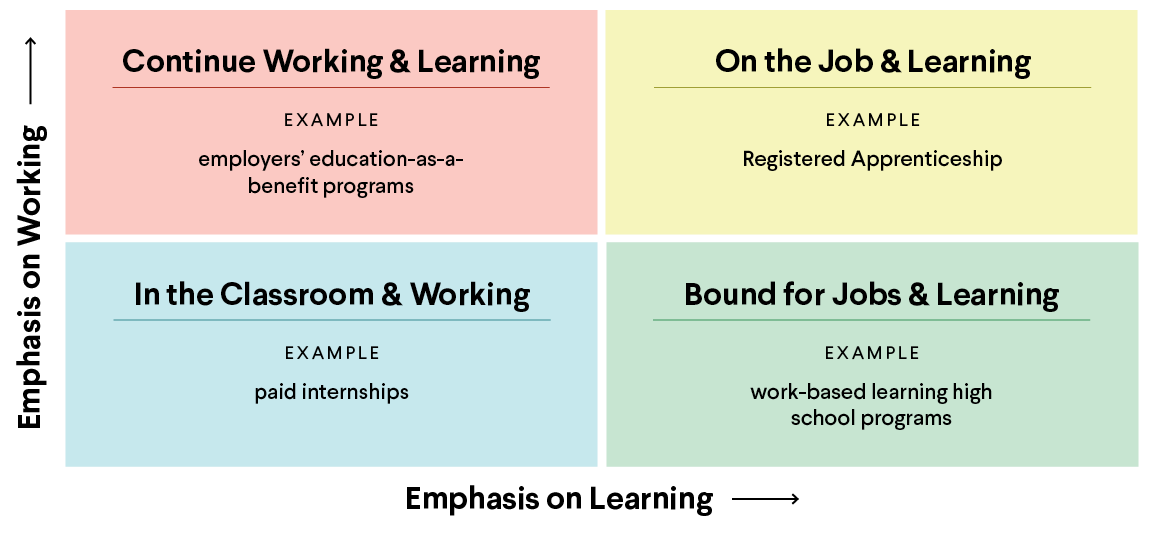A Road Map of Opportunities for Stakeholders
Using the JFF earn-and-learn market segmentation framework, funders, government agencies, and impact investors can identify promising high-quality approaches within earn-and-learn models. Working collaboratively, they can use this framework as a unifying tool to align strategies and contribute collectively to advancing earn-and-learn initiatives. Here’s a look at possible strategies.
Funders and individual donors can enhance their impact by using their resources to strengthen and expand the capacity of effective models. This involves championing effective solutions, shaping narratives through marketing channels, providing valuable data and insights on return on investment, and sharing information through narrative campaigns and case studies about topics such as best practices related to income share agreements. This collaborative effort should extend across networks, with individuals reaching out to colleagues and partners to garner additional support.
When making direct investments, a strategic approach could involve allocating funds to high school models that deliver strong educational outcomes while supporting tools that enhance employer return on investment. Additionally, there’s a valuable opportunity to support learner recruitment initiatives in communities that have long been underserved by existing systems and institutions.
Government agencies and workforce development leaders can play a crucial role in advancing earn-and-learn models by leveraging their positions and drawing upon tools from conventional education pathways. For example, they could design financial aid support systems that mirror those available for people in higher education degree programs but are specifically for nondegree pathways like apprenticeships and other work-based learning programs. This approach would enable the seamless integration of proven tools.
There is also potential to allocate more unrestricted operational and capacity funds for intermediaries. And strategic financial backing can help successful models that deliver robust outcomes.
Another way to enhance government investment would be to amplify local tax incentives for hiring apprentices or pre-apprentices. This would benefit local economies and potentially expand apprenticeship opportunities for members of populations that have long been underrepresented in quality jobs.
Impact investors can be catalysts of innovation in the earn-and-learn ecosystem by providing financial support for tech-enabled solutions that have the potential to rapidly scale learning models while concurrently upholding quality standards and cost efficiencies.
Impact investors can also play an important role by championing employer adoption of these technologies. They could engage in collaborative efforts with other funders and investors and align capital structures to support programs where traditional investments alone may fall short. By taking this multifaceted approach, impact investors would put themselves at the forefront of efforts to drive innovation and catalyze employer adoption.
Fueling Overlapping Investments to Fill Gaps
When multiple funders come together to engage in collaborative efforts, they play pivotal roles because they leverage one another’s strengths and have the capacity to fill gaps that are too big for individual funders to fill on their own. For example, a nonprofit-operated high school program utilizing a high-growth tech platform and offering wraparound services may benefit when students have access to financial aid and employers can take advantage of tax incentives. In such a scenario, the partners each play their own roles, but collectively they have an impact that’s bigger than the sum of its parts.
Collaboration extends beyond direct program support, encompassing philanthropic investments in data capacity development efforts and backing for policymakers who work across sectors. This collective support enhances data outputs, offering valuable insights for government initiatives, aiding in the formulation of policies that facilitate scaling solutions for state agencies focused on K-12 and higher education workforce and labor goals. Furthermore, it provides a crucial background for impact investors seeking new companies to add to their portfolios.
Recognizing the importance of collaboration, every stakeholder should focus on supporting high-quality systems rather than individual programs. This strategic approach ensures a holistic and impactful contribution to the advancement of earn-and-learn models.
Reach Out to a JFF Expert for Support to Launch Your Strategy
JFFLabs offers a comprehensive lineup of tools, frameworks, and research to assist stakeholders in navigating their roles within the quality jobs ecosystem. Visit JFF.org to learn more about earn-and-learn solutions and to get in touch.








